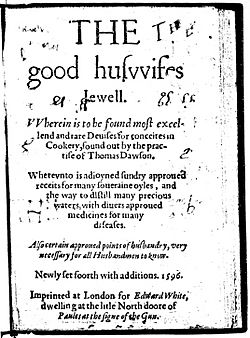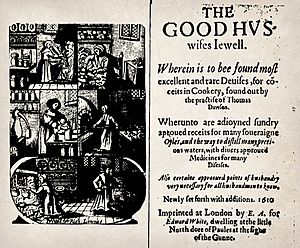The Good Huswifes Jewell facts for kids

Title page of 1596 edition
|
|
| Author | Thomas Dawson |
|---|---|
| Country | England |
| Language | Early Modern English |
| Subject | Cookery |
| Publisher | Edward White |
|
Publication date
|
1585 |
| Pages | 53 double-page spreads |
The Good Huswifes Jewell is an old English cookbook written by Thomas Dawson. It was first published in 1585. This book isn't just about food; it also has recipes for medicines!
In the Middle Ages, English cooking used a lot of spices. This book added more herbs, like parsley and thyme. Many dishes in the book use sugar. It also features ingredients we don't often see in cooking today, such as violets and rosewater.
Some recipes are still popular, like pancakes, haggis, and salads with vinaigrette dressing. Other dishes are less common now, like "mortis," which was a sweet chicken pâté. Some foods have familiar names, like trifle, but they were made with very different ingredients back then.
The Good Huswifes Jewell was the first English cookbook to include a recipe for sweet potatoes.
Contents
A Look at Elizabethan Cooking
The time when this book was written, called the Elizabethan era, was a period of big changes. Cooking styles were evolving. New ingredients arrived in England because of trade with other countries. People also started using more local herbs, not just imported spices.
Cooking began to be seen as its own skill. Before this, cooking instructions were often found in books about medicine or "secrets." We don't know much about the author, Thomas Dawson. We only know that he published several cookbooks, including this one.
These cookbooks were becoming available to more people. They weren't just for rich families anymore. That's why the book is called The Good Huswifes Jewell. A "huswife" was a woman who managed a household.
What's Inside the Book
The Good Huswifes Jewell has many recipes. You can find out how to make fruit tarts using apples, peaches, cherries, damsons, pears, and mulberryes.
Stuffing and Sauces
For stuffing meat or poultry, Dawson suggests using herbs like thyme, hyssop, and parsley. These were mixed with egg yolk, white bread, raisins or barberries, and spices such as cloves, mace, cinnamon, and ginger. Imagine all those flavors in one dish!
A sauce for pork was made with white wine, broth, nutmeg, and herbs like rosemary, bay, thyme, and marjoram.
Familiar Recipes, Old Style
The book includes recipes for pancakes. They were made with cream, egg yolks, flour, and a little ale. The instructions said to cook them on a very soft fire. You had to turn them to bake both sides until they were as dry as possible without burning.
Blancmange is another dish found in the book, called "Blewmanger." It was made with cream, eggs, sugar, and rosewater.
How Recipes Were Written
The recipes in the book are like goals. For example, "To make a Tarte of Spinadge" is a title. Then, it gives instructions on how to make it.
The book doesn't always give exact amounts for ingredients. It might say "a good handful of persely and a few sweet hearbs" or "the yolks of 4 hard egges." Cooking times are also not always clear. Sometimes it says "let them seeth a quantitye of an houre." Instructions for the fire are given when needed, like "boyle it in a chafing dish of coales" (cook it over hot coals) or "with a fyre of Wood beate it the space of two houres" (stir it over a wood fire for two hours).
Salad with Vinaigrette
Here is a recipe for a salad from the 1596 edition. It shows how recipes were written back then:
To Make a Sallet of All Kinde of Hearbes
Take your hearbes and picke them very fine into faire water, and picke your flowers by themselues, and washe them al cleane, and swing them in a strainer, and when you put them into a dish, mingle them with Cowcumbers or Lemmons payred and sliced, and scrape Suger, and put in vineger and Oyle, and throwe the flowers on the toppe of the sallet, and of every sorte of the aforesaide things and garnish the dish about with the foresaide things, and harde Egges boyled and laide about the dish and upon the sallet.
This recipe is even used by the National Trust today. They call it "Stourhead herb and flower salad."
Book Structure
The 1596 edition of the book was organized like this:
- It started with how to serve meat dishes and their sauces.
- Then came "A Booke of Cookerie" (39 double pages of recipes).
- Next were "Approued pointes of Cookerie" (approved cooking tips), "Approued pointes of Husbandrie" (approved farming tips), and "Approued Medicines for sundry diseases."
- Finally, there was an index to help readers find recipes.
Part II (1597)
A second part of the book was published in 1597. It included:
- "A Booke of Cookerie" (72 single pages).
- "The Booke of Caruing and Sewing" (38 unnumbered pages). This section taught how to carve meat and serve food.
- It had "Tearmes of a Caruer" (carving terms).
- It also explained "How to make Marchpaine and Ipocras" (marzipan and a spiced wine drink).
Illustrations in the Book
The book has a frontispiece, which is an illustration at the very beginning. In the 1610 edition, this picture shows six different kitchen scenes. You can see a three-legged pot over a fire, people making distilled drinks, a bread oven, and pots and roasts cooking on a spit over a fire.
Medicine Recipes
Dawson's book also included recipes for medicines. Some of these involved "sympathetic magic." This was a belief that things that looked alike or were connected could affect each other.
For example, the book describes "a tart to provoke courage in either man or woman." This recipe called for the brains of male sparrows. Another remedy was for torn muscles. It suggested taking "worms while they be nice" (meaning fresh), crushing them, and putting them on the sore area. The book claimed this would heal the muscle.
Different Editions
The Good Huswifes Jewell was very popular and was printed many times:
- The first edition was published by Edward White in 1585.
- A second edition came out in 1596. This one was reprinted in 1996 by Southover Press.
- A third edition was published in 1610.
A separate book called The Second Part of the good Hus-wiues Jewell was published in 1597.


